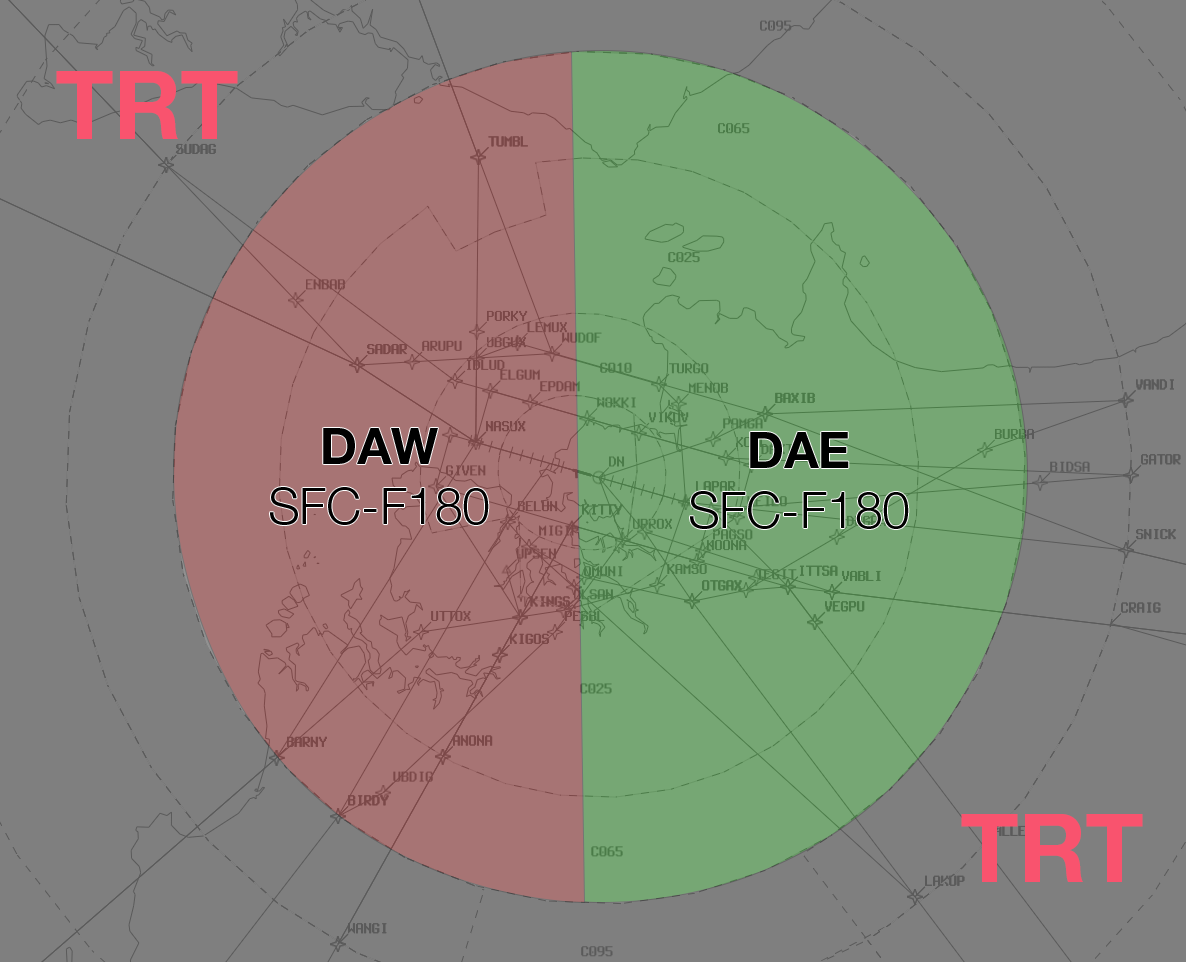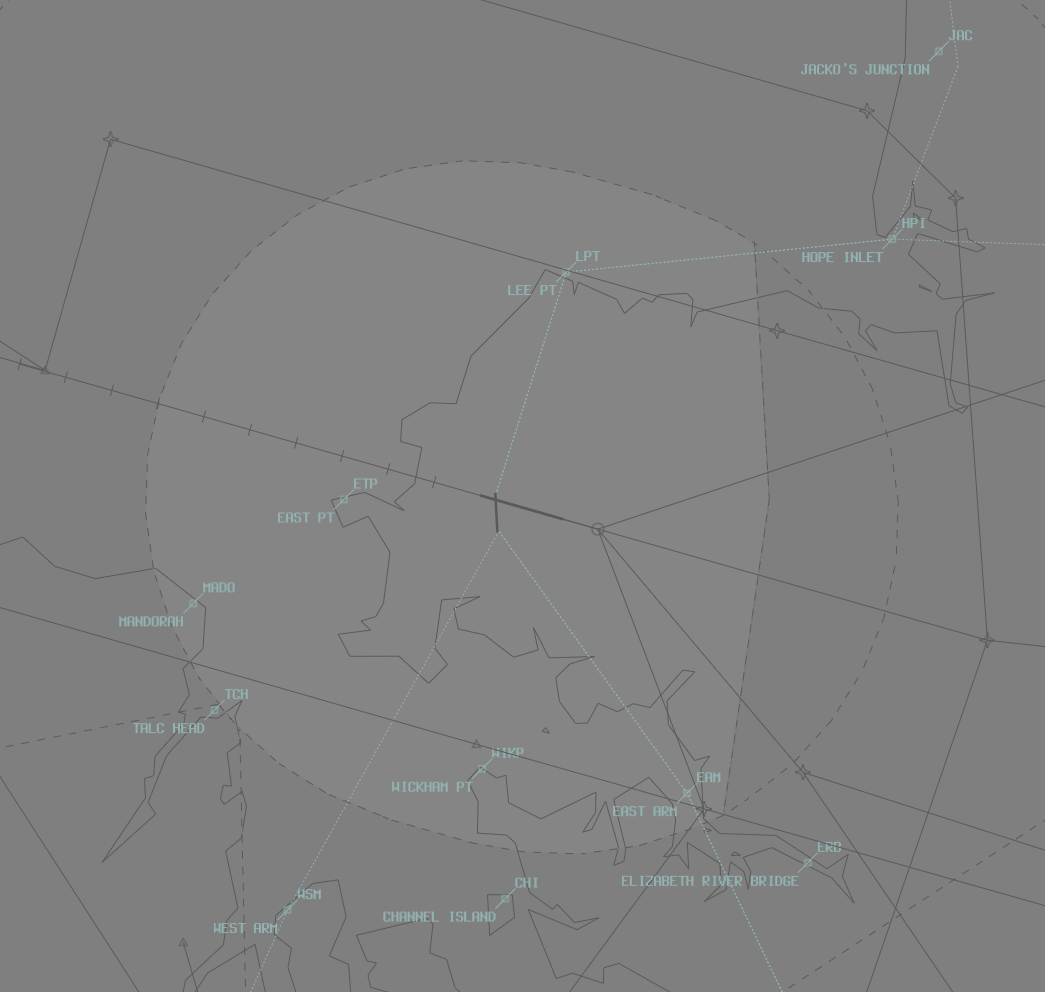Darwin TCU
Positions
| Name | ID | Callsign | Frequency | Login Identifier |
|---|---|---|---|---|
| Darwin Approach East | DAE | Darwin Approach | 125.200 | DN_APP |
| Darwin Approach West† | DAW | Darwin Approach | 134.100 | DN-W_APP |
† Non-standard positions may only be used in accordance with VATPAC Air Traffic Services Policy
Airspace
TCU
DN TCU owns the airspace within a 40NM radius of the DN DME from SFC–FL180
DN TCU is also responsible for Active Restricted Area R264 A-K and R230 A-F
DAW may request DN TCU (SFC–F240) from TRT to facilitate military transits to/from R264 A-K and R230 A-F
Airspace Division
When both DN TCU positions are opened, DN TCU is split east and west along the runway 18/36 extended centreline. DAW owns the airspace to the west of the line and DAE owns the airspace to the east of the line

ADC
ADC owns the airspace within the DN CTR (SFC–A010). This airspace is designed to facilitate the processing of helicopter scenic flights and low-level helicopter circuits.
The CTR extends 7NM from the thresholds of runways 11 and 29 but does not including the Robertson Barracks transit zone.
ADC may request DN TCU (SFC–A020) from DN TCU to facilitate fixed-wing circuit operations:
a) Fixed-wing circuit operations are typically conducted at Delissaville (YDLV) due to high traffic density at Darwin
b) ADC may deny requests for circuits if IFR traffic may be unduly delayed

Surveillance
DN ADC is permitted to use Surveillance standards for separation. Surveillance coverage can be expected to be available at all levels in the DN ADC airspace.
For simulation purposes, visual separation is assumed to exist below the cloud base, and within 7nm of the aerodrome. Visual separation can still be used to separate from aircraft on an instrument approach, below the cloud base.
Aerodrome
Runway Modes
Runway selection shall be coordinated by DN ADC. In any case, a change of runway mode shall not be broadcast on the ATIS until DAW accepts the change.
The Runway Mode options available are:
a) Runway 29 and Runway 36;
b) Runway 29 and Runway 18;
c) Runway 29 only;
d) Runway 11 and Runway 36;
e) Runway 11 and Runway 18;
f) Runway 11 only.
Non-RNAV Departures
For non-RNAV approved IFR aircraft with a wake turbulence category of medium or greater, issue a Radar SID
For non-RNAV approved IFR aircraft with a wake turbulence category of light, issue a visual departure or Radar SID
Charts
Note
Additional charts to the AIP may be found in the RAAF TERMA document, available towards the bottom of RAAF AIP page
Miscellaneous
IFR Training Area
IFR aircraft requiring an area for training shall be cleared to operate in the North Eastern Training Area (NETA)
The NETA is defined as the area between DN 360R–060R from 15NM–30NM DN DME.
Aircraft are to be cleared to the NETA via the 030R outbound. Vertical limits are to be specified by DAW prior to issuing airways clearance
Designated Fuel Dumping Area
Other than in an emergency, the designated fuel jettison area is:
a) Over water in the Beagle Gulf
b) Between the 320 and 020 TACAN radials
c) A060 or above
Robertson Barracks
Darwin TCU is not responsible for traffic or separation services within the A005 step to the east of Darwin. This step is designed for low-level VFR MIL helos to transit in/out of Robertson Barracks without the need for communication with Darwin TCU.
Coordination
Enroute
Departures
Voiceless for all aircraft:
- Tracking via a Procedural SID terminus; and
- Assigned the lower of
F180or theRFL
All other aircraft going to TRT CTA must be Heads-up Coordinated by DN TCU prior to the boundary.
Example
DN TCU -> TRT: "PFY1234, with your concurrence, will be assigned F160, for my separation with JTE654"
TRT -> DN TCU: "PFY1234, concur F160"
Arrivals
Voiceless for all aircraft:
- With ADES YPDN; and
- Assigned a STAR; and
- Assigned
A100
All other aircraft coming from TRT CTA will be Heads-up Coordinated to DN TCU.
ADC
Airspace
DN ADC owns the airspace within the DN CTR SFC–A010.
Auto Release
"Next" Coordination is a procedure where the DN ADC controller gives a heads-up to the DN TCU controller about an impending departure. The DN TCU controller will respond by assigning a heading to the aircraft, for the DN ADC controller to pass on with their takeoff clearance.
Example
DN ADC -> DN TCU: "Next, ABC, runway 18"
DN TCU -> DN ADC: "ABC, Track Extended Centreline, unrestricted"
DN ADC -> DN TCU: "Track Extended Centreline, unrestricted, ABC"
All departures from 18/36 require departure coordination with DN TCU
VFR Departures
A020 or the planned level; whichever is lower, to all VFR aircraft.
VFR aircraft are required to track via one of the published VFR Routes.
VFR routes shall be assigned based on the destination radial from Darwin.
Assign VFR routes in accordance with the following radial chart:
| Outbound Radial | Assigned VFR Route |
|---|---|
| 360 – 040 | VFR Route 1 |
| 041 – 084 | VFR Route 2 |
| 085 – 124 | VFR Route 3 |
| 125 – 180 | VFR Route 4 |
| 181 – 224 | VFR Route 5 |
| 225 – 359 | Direct |
Tip
If a VFR aircraft has not planned via a VFR route as above, use the phraseology: “ABC, cleared amended route VFR route 1, maintain A020, squawk 4512”
Auto-Release Wedge
The Darwin auto-release wedges extend from the departure end runway threshold, 30 degrees splayed from the centreline, to 7nm
Auto-release at Darwin is only available for VFR aircraft and low-level IFR aircraft.
Tower may depart aircraft that conform with the above conditions within the auto-release wedge using the following headings:
| Departure Type | Runway 11 | Runway 29 |
|---|---|---|
| VFR | H070V, H106V or H140V | H260V, H286V or H320V |
| IFR (Visual Dep) | H070V, H106V, or H140V | H260V, H286V or H320V |
| IFR (Radar) | H070, H106 or H140 | H260, H286 or H320 |
Tip
Tower shall provide visual separation between aircraft in the auto-release wedge and subsequent departures until the preceding departure has been maneuvered by TCU
IFR Level Assignment
Issue F180 or RFL; whichever is lower, to aircraft cleared via an RNAV SID or aircraft with a wake turbulence category of medium or greater.
Issue F180 or RFL; whichever is lower, to jet aircraft not cleared via an RNAV SID regardless of wake turbulence category.
Issue A030 or RFL; whichever is lower, to aircraft not cleared via an RNAV SID with a wake turbulence category of light.
DN TCU Internal
Heads-up coordination is not required between DAW and DAE for:
- Departures on a Procedural SID and assigned
F180 - Arrivals on a STAR assigned
A060
All other aircraft must be heads-up coordinated prior to the airspace boundary
Example
DAW -> DAE: "via DN, CFH23"
DAE -> DAW: "CFH23, A090"